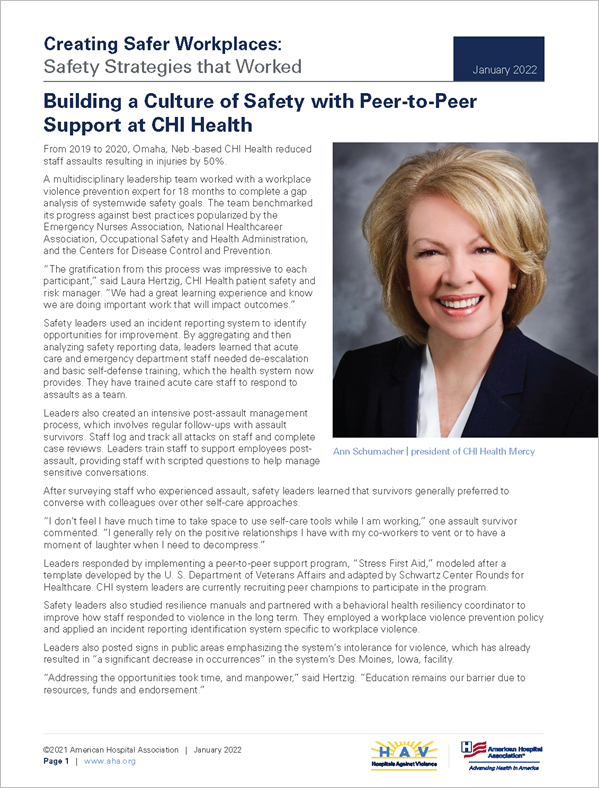Case Study: Building a Culture of Safety with Peer-to-Peer Support at CHI Health
From 2019 to 2020, Omaha, Neb.-based CHI Health reduced staff assaults resulting in injuries by 50%.
A multidisciplinary leadership team worked with a workplace violence prevention expert for 18 months to complete a gap analysis of systemwide safety goals. The team benchmarked its progress against best practices popularized by the Emergency Nurses Association, National Healthcareer Association, Occupational Safety and Health Administration, and the Centers for Disease Control and Prevention.
“The gratification from this process was impressive to each participant,” said Laura Hertzig, CHI Health patient safety and risk manager. “We had a great learning experience and know we are doing important work that will impact outcomes.”
Safety leaders used an incident reporting system to identify opportunities for improvement. By aggregating and then analyzing safety reporting data, leaders learned that acute care and emergency department staff needed de-escalation and basic self-defense training, which the health system now provides. They have trained acute care staff to respond to assaults as a team.
Leaders also created an intensive post-assault management process, which involves regular follow-ups with assault survivors. Staff log and track all attacks on staff and complete case reviews. Leaders train staff to support employees post-assault, providing staff with scripted questions to help manage sensitive conversations.
After surveying staff who experienced assault, safety leaders learned that survivors generally preferred to converse with colleagues over other self-care approaches.
“I don’t feel I have much time to take space to use self-care tools while I am working,” one assault survivor commented. “I generally rely on the positive relationships I have with my co-workers to vent or to have a moment of laughter when I need to decompress.”
Leaders responded by implementing a peer-to-peer support program, “Stress First Aid,” modeled after a template developed by the U. S. Department of Veterans Affairs and adapted by Schwartz Center Rounds for Healthcare. CHI system leaders are currently recruiting peer champions to participate in the program.
Safety leaders also studied resilience manuals and partnered with a behavioral health resiliency coordinator to improve how staff responded to violence in the long term. They employed a workplace violence prevention policy and applied an incident reporting identification system specific to workplace violence.
Leaders also posted signs in public areas emphasizing the system’s intolerance for violence, which has already resulted in “a significant decrease in occurrences” in the system’s Des Moines, Iowa, facility.
“Addressing the opportunities took time, and manpower,” said Hertzig. “Education remains our barrier due to resources, funds and endorsement.”


